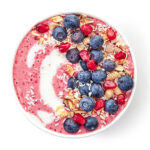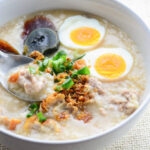Chef’s Salad is a classic American dish that combines fresh lettuce, vegetables, meats, cheese, and dressing to create a hearty and flavorful salad. It’s a versatile and customizable option often enjoyed as a main course or side dish, showcasing a balanced mix of textures and flavors.
| Ingredients: | |
| 1 | 4 cups of mixed lettuce (iceberg, romaine, or your preferred greens) |
| 2 | 1 cup diced cooked ham |
| 3 | 1 cup diced cooked turkey or chicken |
| 4 | 1 cup diced cheddar or Swiss cheese |
| 5 | 2 hard-boiled eggs, sliced or chopped |
| 6 | 1 cup cherry tomatoes, halved |
| 7 | 1/2 cucumber, sliced |
| 8 | 1/2 red onion, thinly sliced |
| 9 | 1/2 bell pepper (any color), diced |
| 10 | 1/4 cup sliced radishes |
| 11 | 1/4 cup croutons (optional) |
| 12 | Salt and pepper, to taste |
| # | For the Dressing: |
| 13 | 1/4 cup olive oil |
| 14 | 2 tablespoons red wine vinegar |
| 15 | 1 teaspoon Dijon mustard |
| 16 | 1 clove garlic, minced |
| 17 | Salt and pepper, to taste |
Step-by-step cooking instruction of Chef’s Salad:
Step-1 Prepare the Dressing: In a small bowl, whisk together the olive oil, red wine vinegar, Dijon mustard, minced garlic, salt, and pepper. Set aside to let the flavors meld.
Step-2 Assemble the Salad: In a large salad bowl, arrange the mixed lettuce as the base. Layer the diced ham, turkey or chicken, cheddar or Swiss cheese, hard-boiled eggs, cherry tomatoes, cucumber, red onion, bell pepper, and radishes on top of the lettuce.
Step-3 Add Croutons (Optional): If you prefer, sprinkle croutons over the salad for added crunch and texture.
Step-4 Drizzle with Dressing: Just before serving, drizzle the salad with the prepared dressing. Use as much or as little dressing as you choose.
Step-5 Season and Serve: Season the salad with a pinch of salt and a sprinkle of freshly ground black pepper to taste. Gently toss the salad with the dressing to coat all of the ingredients.
Step-6 Serve the Chef’s Salad immediately as a satisfying and flavorful meal.
Nutritional values of Chef’s Salad:
Nutritional Values for a Typical Chef’s Salad:
These values are based on a serving size of about 1 large salad (approx. 2-3 cups of salad).
| 1 | Calories: Approximately 400-500 calories |
| 2 | Protein: About 25-30 grams |
| 3 | Carbohydrates: Approximately 10-15 grams |
| 4 | Dietary Fiber: Around 3-5 grams |
| 5 | Sugars: Approximately 3-4 grams |
| 6 | Fat: About 28-35 grams |
| 7 | Saturated Fat: Around 8-10 grams |
| 8 | Unsaturated Fats: Approximately 18-25 grams |
| 9 | Cholesterol: Approximately 200-250 milligrams |
| 10 | Sodium: About 900-1100 milligrams |
Background History of Chef’s Salad:
The exact origin of the Chef’s Salad is somewhat unclear, and there are several theories about its creation. While the details might vary, most accounts agree that the Chef’s Salad has American roots and emerged in the early to mid-20th century.
Here are a couple of theories about the background history of Chef’s Salad:
Julius Caesar’s Chef:
One popular theory links the creation of Chef’s Salad to the renowned Italian-American chef Caesar Cardini, who is credited with inventing the Caesar Salad. It is believed that Cardini’s chef created the Chef’s Salad as a way to use up leftovers in the kitchen. This salad was initially intended to showcase the ingredients available and demonstrate the chef’s creativity. Over time, it gained popularity and became a staple on restaurant menus.
Ransom Olds and the “Salad à la Ransom”:
Another theory traces the roots of Chef’s Salad to Ransom Olds, an American automobile pioneer. In the early 20th century, Ransom Olds frequented the Waldorf-Astoria Hotel in New York City. The story goes that Olds enjoyed a particular salad prepared by the hotel’s chef and requested that the dish be named after him. The salad, known as “Salad à la Ransom,” was composed of lettuce, bacon, chicken, eggs, and a French dressing. This early version of the salad could be considered a precursor to the modern Chef’s Salad.
Regardless of its exact origin, the Chef’s Salad became popular in the mid-20th century and has since evolved into a versatile and customizable dish enjoyed in homes and restaurants across the United States and beyond. Its appeal lies in its combination of fresh ingredients, variety of flavors, and satisfying nature, making it a favorite choice for those seeking a balanced and substantial meal.
While the specific details of the creation of Chef’s Salad may remain somewhat elusive, its history reflects the creativity and innovation of chefs and culinary professionals, who transformed simple ingredients into a beloved and enduring culinary classic.
| Advantages of Chef’s Salad | |
| 1 | Nutrient-Rich: Chef’s Salad is typically packed with a variety of vegetables, proteins, and other nutritious ingredients, making it a great way to consume a wide range of nutrients in one meal. |
| 2 | Balanced Meal: The combination of vegetables, proteins, and healthy fats in Chef’s Salad can provide a well-rounded and satisfying meal, helping you feel full and satisfied. |
| 3 | Customizable: Chef’s Salad is highly versatile and can be customized to suit your preferences and dietary needs. You can choose your favorite vegetables, proteins, cheeses, and dressings. |
| 4 | Portion Control: It’s easy to control portion sizes with Chef’s Salad, making it a helpful option for those looking to manage their calorie intake. |
| 5 | Convenience: Chef’s Salad can be prepared ahead of time and stored in the refrigerator, making it a convenient option for busy individuals or for meal prep. |
| 6 | Texture and Flavor Variety: The mix of textures and flavors from the different ingredients adds complexity and enjoyment to each bite. |
| Disadvantages of Chef’s Salad | |
| 1 | Caloric Content: Depending on the ingredients and dressing used, Chef’s Salad can be calorie-dense, especially if high-fat or high-calorie toppings are added. This could be a concern for those watching their calorie intake. |
| 2 | Saturated Fat and Sodium: Ingredients like processed meats, cheese, and certain dressings can contribute to higher levels of saturated fat and sodium, which may not be suitable for individuals with certain health conditions. |
| 3 | Allergens: Chef’s Salad often contains common allergens like eggs, dairy, and gluten (in croutons). This can be a limitation for individuals with allergies or sensitivities. |
| 4 | Nutrient Imbalance: While Chef’s Salad can be nutrient-rich, it’s important to ensure a balance of nutrients. Overloading on cheese or fatty dressings, for instance, might skew the nutritional balance. |
| 5 | Lack of Satiety: Depending on portion size and ingredient choices, some individuals might find that a Chef’s Salad doesn’t keep them full for an extended period, leading to potential overeating later. |
| 6 | Dressings and Toppings: Creamy dressings and calorie-dense toppings like bacon or fried onions can significantly increase the overall calorie and fat content of the salad. |
Compare with similar meal of Chef’s Salad:
If you’re looking for similar meals to Chef’s Salad that offer a mix of fresh ingredients, proteins, and flavors, there are several options to consider. Here are a few similar meal ideas:
| 1 | Cobb Salad: Cobb Salad is another classic American salad that features a variety of ingredients arranged in rows or sections. It typically includes lettuce, grilled chicken, bacon, hard-boiled eggs, avocado, tomatoes, blue cheese, and a vinaigrette dressing. Like Chef’s Salad, it’s hearty and satisfying. |
| 2 | Greek Salad: A Greek Salad combines crisp lettuce, tomatoes, cucumbers, red onions, Kalamata olives, and feta cheese, usually dressed with olive oil and lemon juice. It can also include bell peppers and oregano for added flavor. |
| 3 | Nicoise Salad: Originating from the French city of Nice, this salad traditionally includes tuna, hard-boiled eggs, olives, green beans, and potatoes on a bed of lettuce. It’s often drizzled with vinaigrette dressing. |
| 4 | Salad Niçoise: Similar to Nicoise Salad but with more cooked components, this dish includes seared tuna, steamed green beans, hard-boiled eggs, tomatoes, and olives over greens, often with a Dijon-based dressing. |
| 5 | Antipasto Salad: Inspired by Italian cuisine, an antipasto salad combines a variety of cured meats (such as salami, prosciutto), cheeses, olives, artichoke hearts, roasted red peppers, and other marinated vegetables over a bed of lettuce. |
| 6 | California Salad: This salad incorporates a mix of ingredients commonly associated with California cuisine, such as grilled chicken, avocado, mixed greens, roasted corn, black beans, and a citrusy dressing. |
| 7 | Harvest Salad: A fall-inspired option, this salad includes ingredients like roasted butternut squash, dried cranberries, toasted nuts, goat cheese, and a balsamic vinaigrette. |
| 8 | Asian Chicken Salad: Featuring grilled or poached chicken, mixed greens, mandarin oranges, sliced almonds, and crispy wonton strips, this salad is often dressed with sesame or ginger dressing. |
| 9 | Tex-Mex Salad: This salad combines flavors of Texan and Mexican cuisines with ingredients like grilled or seasoned meat, black beans, corn, avocado, tomato, shredded cheese, and tortilla strips. |
| 10 | Spinach and Strawberry Salad: A lighter option, this salad pairs baby spinach with fresh strawberries, sliced almonds, goat cheese, and a balsamic or poppy seed dressing. |
Mostly questions asked about Chef’s Salad
1: What is a Chef’s Salad?
A: A Chef’s Salad is a classic American salad that typically consists of fresh lettuce, vegetables, meats (such as ham and turkey), cheese, hard-boiled eggs, and a flavorful dressing. It’s known for its hearty and satisfying nature.
2: Who invented the Chef’s Salad?
A: The exact inventor of the Chef’s Salad is debated, but it’s believed to have emerged in the early to mid-20th century. Some theories link it to Italian-American chef Caesar Cardini, while others attribute its creation to chefs showcasing their creativity.
3: Can I customize a Chef’s Salad?
A: Absolutely! Chef’s Salad is highly customizable. You can choose your preferred vegetables, proteins, cheeses, and dressings to create a salad tailored to your taste.
4: Is Chef’s Salad a healthy option?
A: Chef’s Salad can be a healthy option when made with fresh, nutrient-rich ingredients and a balanced dressing. However, be mindful of portion sizes and high-calorie toppings.
5: What dressings can I use for Chef’s Salad?
A: Popular dressings for Chef’s Salad include ranch, blue cheese, Italian, vinaigrette, or a simple olive oil and vinegar mix. Choose a dressing that complements your chosen ingredients.
6: Is Chef’s Salad suitable for vegetarians?
A: Yes, Chef’s Salad can be easily adapted for vegetarians by omitting the meat and adding extra vegetables, beans, or plant-based protein sources.
7: Can I make Chef’s Salad ahead of time?
A: Yes, Chef’s Salad can be prepped ahead of time. However, it’s best to wait until just before serving to add the dressing to prevent the salad from becoming soggy.
8: Is Chef’s Salad considered a main dish or a side dish?
A: Chef’s Salad can be enjoyed as both a main dish and a side dish, depending on portion size and personal preference.
9: What’s the difference between Chef’s Salad and Cobb Salad?
A: While similar, Cobb Salad typically includes grilled chicken, bacon, avocado, and blue cheese in addition to other ingredients. Chef’s Salad tends to have a broader variety of meats and cheeses.
10: Can Chef’s Salad help with weight loss?
A: Chef’s Salad can be a filling and lower-calorie option when made with lean proteins, lots of vegetables, and a lighter dressing. It can support weight loss goals by providing a balanced and satisfying meal.







